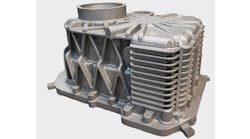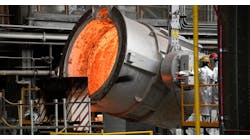For decades, U.S. manufacturers reaped considerable production-cost savings by moving their operations offshore, primarily due to the low cost of foreign labor. But today, economic and geopolitical factors have caused the balance to shift, and manufacturers across industrial sectors are concluding that offshoring no longer makes good business sense.
Although the reshoring trend began in earnest around 2010, the past few years have seen a sharp increase in businesses moving some or all of their operations back to the United States. This phenomenon is due in part to rising labor costs worldwide that have made the U.S. manufacturing workforce more competitive. Also significant is a growing awareness of fault lines in the global supply chain, made obvious in the protracted COVID-19 era.
Some supply-chain malfunctions are purely due to logistical breakdowns, such as the 2021 blockage of the Suez Canal. Others have been exacerbated by global politics, for example, when China completely cut-off access to its foreign manufacturing during the pandemic.
Price-per-part vs. TCO
Another notable factor motivating U.S. manufacturers to reshore is a wholesale shift in perspective, from price-per-part cost modeling to a total-cost-of-ownership mindset. Rather than simply calculating the unit cost of manufacturing individual components, many manufacturers are now taking stock of various other direct and indirect costs associated with the foreign manufacturing process:
• Direct costs of manufacturing, which now include record-high shipping rates, the capital required to manage offshore vendors, and the purchase of surplus inventory to mitigate the effects of supply-chain disruptions.
• Indirect costs related to risk prevention and reputation management. When offshoring, there’s less control over the customer-service experience, concern over security and intellectual property protections in countries with different legal requirements, and—perhaps most significant—a growing pressure for businesses to align with environmental, social, and government (ESG) standards by reducing their carbon footprint and ensuring safe labor practices in their facilities.
Trends influencing reshoring
While manufacturers are reshoring work from numerous countries, Korea, Vietnam, Japan, and Canada top the list. Two of the top trending factors currently influencing manufacturers’ decisions to reshore are noteworthy, demonstrating 700% year-over-year increases from 2021-2022:
• Social and ethical concerns due to human rights abuses in China and a growing focus on ESG considerations.
• Made in America, specifically Walmart’s $350-billion commitment to sourcing U.S.-made products.
Other factors trending up include manufacturers inventory shortfalls due to supply-chain disruptions, rising freight costs, and the ability to mitigate high U.S. labor costs with automation.
Whatever the motivation, reshoring has outpaced foreign direct investment (FDI) in job creation for three consecutive years, creating a wealth of new employment opportunities in domestic manufacturing.
Reshoring isn’t inevitable
Despite the recent spike in reshoring activity, the future of U.S. manufacturing remains to be seen. Businesses will undoubtedly experience some growing pains as they transition away from long-held practices, and the disparity between labor costs in the U.S. and abroad may widen again over time.
For reshoring to truly stick and continue bolstering the U.S. economy, manufacturers must work diligently to offer improved products and impeccable customer service that will dramatically surpass the capabilities of foreign manufacturers.
Their efforts should involve tactics including but not limited to:
• Maintaining quick responsiveness to RFQs;
• Communicating proactively about ways to lower customer costs or decrease lead times;
• Providing failsafe security and IP protection;
• Consistently delivering orders on time.
Just as important, manufacturers must keep vendors with questionable labor or environmental practices out of their supply chains so that they can earn or maintain an industry reputation as good actors. In many ways, businesses that bring operations back to the United States will find this level of service much easier to deliver.
Having facilities located in the same or similar geographical area and time zone will simplify communication and travel between sites to inspect parts and discuss workflows. And supply chains that are shorter and more predictable will mean fewer fulfillment delays and greater compliance with rigorous market standards for quality control and security.
Preparing for reshoring
To build upon the recent reshoring momentum, manufacturers can act immediately by modernizing in these four critical ways:
1. Expanding the workforce. Although reshoring has already created hundreds of thousands of manufacturing jobs in the United States, there is a severe shortage of skilled laborers to fill them, a problem that preceded the pandemic.
Manufacturers should increase their efforts to inform the next generation of employees about the diverse and often lucrative career opportunities in their sectors, targeting young people who are considering alternatives to college and populations who traditionally have not been encouraged to apply for manufacturing jobs.
2. Investing in technology. Modern technology can help fill labor gaps and keep U.S. manufacturers competitive by reducing costs. For instance, robots can perform repetitive, strenuous, or dangerous tasks on the floor, protecting workers from physical strain and freeing them up to perform more skilled tasks. Software solutions can streamline tasks like quoting and programming to make the front office and shop floor run more efficiently.
3. Focusing on security. Safeguards for intellectual property vary widely from country to country. When manufacturing occurs offshore, manufacturers lack the IP protection conferred by making their products in the U.S. IP security has proven to be a big incentive for reshoring.
Domestic manufacturers must have airtight systems to prevent theft or loss of IP for themselves and their customers so that they can strike a clear contrast with foreign manufacturers.
4. Advocating for manufacturers. Government incentives—such as those established via the recent Inflation Reduction Act—are helping to drive reshoring efforts. To continue receiving support and funding, manufacturers must make their voices heard at all levels of government.
Advocacy groups such as the National Tooling and Machining Association (NTMA) are excellent resources for working with other manufacturers toward a common goal.
The current momentum behind reshoring presents a tremendous opportunity for the manufacturing industry and the U.S. economy alike. By streamlining workflows and maintaining greater oversight of supply chains and intellectual property, U.S. manufacturers can seize the moment and ensure that reshoring is here to stay.
Jason Ray is the founder and CEO of Paperless Parts, a secure, cloud-based platform that lets custom-parts manufacturers quote faster and more accurately, streamline communications, and grow their businesses.









